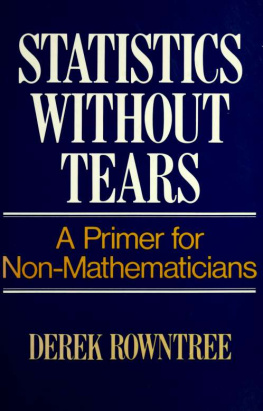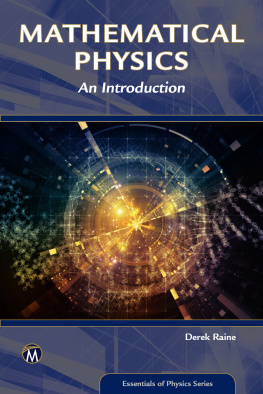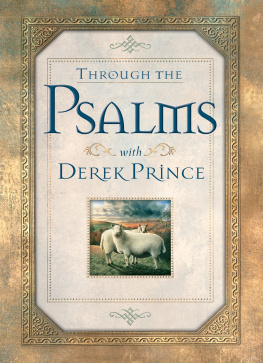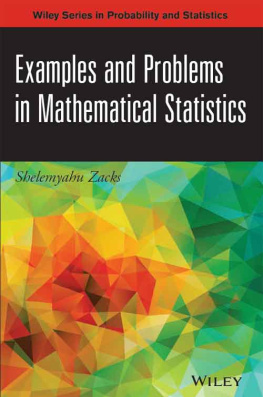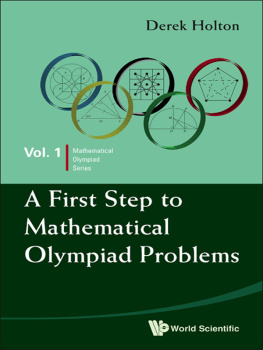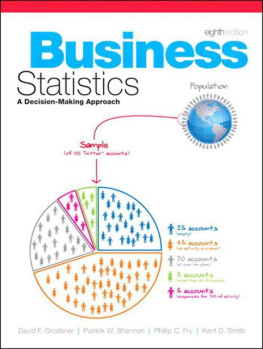This book made available by the Internet Archive.
Acknowledgements
This book is dedicated to Professor Peter Moore of the London Business School who gave me just the kind of confidence in approaching statistics that 1 hope my book will give to its readers.
I take this opportunity also of thanking my Open University colleagues, Professor Brian Lewis, John Bibby, Gordon Burt and Fred Lockwood - and Penguin's advisory editor, David Nelson -for their detailed and constructive comments on earlier drafts which helped me greatly in preparing this final version of the book. Lastly, I thank my secretary, Heida Darling, for producing the immaculate typescript on which those comments were made.
Introduction
So here is yet another introductory book about statistics. Who needs it? What makes me believe I can lead students into the subject along paths that have not already been trodden flat by authors galore?
Perhaps I can best tell you how different this book is going to be by mentioning some of the possible titles I considered for it: Statistics Without Calculations^ Statistics for the Innumerate, Statistics in Words and Pictures^ The Underlying Ideas oj Statistics^ and How to Think Statistically.
All of these say something about my attitudes and intended approach. The first two titles recognize that many non-mathematicians take (are made to take?) a course in statistics as part of some wider program of studies. Such non-mathematical students may be more than a little dismayed at the sight of pages bristling with formulae, equations and calculations. As it happens, many statistics textbooks begin by promising that *the reader will need no more than the ability to add, subtract, multiply and divide, and to substitute numbers for letters in formulae.' But most soon go on to lose him (or her) in calculations so involved and time-consuming that the student forgets about the concepts that the calculations are supposed to illustrate. He can't see the statistical wood for the computational trees.
The third title expresses how I intend to teach the essentials of statistics without computation - by relying on the power of words and pictures. The last two titles indicate where I believe the emphasis should lie in an introductory text - not on calculations but on ideas. This book does not teach you how to chew up numbers and spit out plausible 'answers' (a pocket calculator could do this for you), but how to understand the key concepts of
10 Introduction
statistics and use them in thinking statistically about whatever real-world problems you find them relevant to. If you are a 'consumer' of statistics (interpreting other people's research reports, for instance), this may be all you need. If, however, you are a 'producer' of statistics, there are plenty of books to show you how to perform all the necessary calculations. And you should find the learning of such computational procedures much more meaningful after having first acquired a conceptual picture of statistics as a whole. For such readers, this book will serve as a useful primer, and that is the idea 1 have embodied in my subtitle.
But as you can see, I ended up with the main title of Statistics Without Tears, from which you may infer that 1 hope to save you from the weeping (and/or wailing and/or gnashing of teeth) that is so often to be heard among students drawn willy-nilly into the study of statistics. But - be warned - 1 do not imply Statistics Without Eff'ort. As you'll see, 1 expect you to work for your understanding!
How to use this book
You will soon notice (if you haven't already) that this book does not present you with the usual stream of continuous text. Instead of offering thousands of words for you to 'read, learn and inwardly digest' as best you can, every now and again I pause to ask you a question. This questioning approach is meant to make the book less like a lecture than a 'tutorial in print' - a technique used with considerable success in the correspondence texts produced by Britain's Open University, and in some modern textbooks.
The questions I ask will not, of course, require you to perform calculations. (The nearest you will normally come to that is when 1 ask you to judge whether something we have discussed is likely to be bigger or smaller than, or about the same size as, something else.) Rather, my questions will require you to recognize examples of the concepts we are discussing, to distinguish between
Introduction 11
examples and non-examples of a given concept, to relate one concept to another, to apply the concepts to practical problems, to predict likely outcomes, to interpret results, and so on. In short, my questions will be asking you not just to read, but also to think about the subject.
So, every now and again, whenever we have got to a point worth emphasizing, you will see a row of asterisks across the page, like the one a few lines below. And just before you get to that row of asterisks you will find I have posed a question of some kind. Here is a question now (a * multiple-choice' question, this one) to get you into the spirit of the thing.
Judging by what I have just said, what do you think will be my main purpose in asking you questions? Is it:
(a) to slow up your reading? or
(b) to help you learn? or
(c) to test what you have learned?
* :K 4e * III
Immediately after the row of asterisks, you will read my comments on possible answers to the question, before we continue with the discussion. So, as far as the question above is concerned, (b) is the answer I hope you'll have chosen. However, it is also true that my questions will slow you up, because they will require you to think as well as to read; in some cases, they will also enable you to test what you have learned so far. However, their main purpose is to ensure that you do learn - by using the ideas we discuss.
So the row of asterisks is meant to act as a visual signal reminding you of this message: please pause here, do not
READ ON UNTIL YOU HAVE ANSWERED THE QUESTION.
Usually, the questions will require only a few seconds' thought, and you will rarely need to write anything down. But do please try to answer each one before going on to read my discussion of it. If you were to skip the questions, you would get through the book a lot faster, but you wouldn't have learned much. In fact, it is quite a good idea to guard against even accidentally seeing my discussion of an answer before trying the question. You may like
12 Introduction
to keep a sheet of paper handy with which to cover the text below the next row of asterisks, until you are ready to read it. Four more points about reading this book, before you begin:

